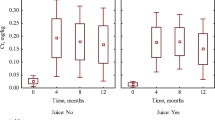Abstract
This prospective study comprised 140 natural crowns of the teeth extracted from 31 boys and 35 men, as well as 39 girls and 35 women. They were divided into two groups. Group I consisted of primary teeth and group II consisted of permanent teeth. In each group, two subgroups were distinguished: subgroup A containing teeth without caries and subgroup B comprising carietic teeth. Zinc, iron, copper, nickel, chromium, cobalt, lead, cadmium, selenium, and strontium were determined in the samples by using the total reflection X-ray fluorescence method. Significantly higher concentrations of zinc, iron, copper, nickel, selenium, and strontium were detected in the crowns of healthy primary and permanent teeth than in the crowns of the carietic primary and permanent teeth. The concentrations of chromium, cobalt, lead, and cadmium were significantly higher in primary and permanent teeth with caries than in the healthy ones. Judging from the obtained results, we think that lower concentrations of zinc, iron, copper, nickel, selenium, and strontium together with higher concentrations of chromium, cobalt, lead, and cadmium in the carietic primary and permanent teeth, in relation with the respective concentrations of those elements in healthy teeth, can be one of the caries risk factors.
Similar content being viewed by others
References
M. Andersen, Risk assessment and epidemiology of dental caries: review of the literature, Pediatr. Dent. 24, 377–385 (2002).
W. H. Bowen, Exposure to metal ions and susceptibility to dental caries, J. Dent. Educ. 65, 1043–1053 (2001).
M. E. J. Curzon and D. C. Crocker, Relationship of trace elements in human tooth enamel to dental caries, Arch. Oral Biol. 23, 647–653 (1978).
M. Barańska-Gachowska, L. Postek, J. Wiśniewska, et al., The condition of milk teeth in school children living in areas of exposure to supranormal concentrations of non-iron metals, Czas. Stomat. 40, 393–398 (1987).
M. Barańska-Gachowska, M. Kamiński, K. Owczarczak, et al., Cu content in teeth of living on the areas contaminated by Zn, Cd and Pb, Czas. Stomat. 41, 406–410 (1988).
G. N. Jenkins, The metabolism and effects of fluoride. in Trace Metals and Fluoride in Bone and Teeth, N. D. Priest and F. L. van der Vyver, eds., CRC, Boca Raton, FL, pp. 141–173 (1990).
M. Strużak-Wysokińska, K. Niedzielska, and J. Błoniarz, Strontium content in hard tissues of milk teeth with without caries, Czas. Stomat. 42, 295–302 (1989).
K. Niedzielska, M. Strużak-Wysokińska, and Z. Wujec, Analysis of correlations between the content of various elements in hard tissues of milk teeth with and without caries, Czas. Stomat. 43, 316–322 (1990).
A. Parko, Has the increase in selenium intake led to a decrease in caries among children and the young in Finland, Proc. Finn. Dent. Soc. 88, 57–59 (1992).
U. Majewska, J. Braziewicz, D. Banaś, et al., Some aspekt of statistical distribution of trace element concentrations in biomedical samples, Nucl. Instrum. Methods Phys. Res. B 158, 254–259 (1999).
B. Nowak, Accumulation of metals in the teeth of two towns in the South Poland, Biol. Trace Element Res. 62, 111–116 (1998).
K. Bercovitz, Tooth type as indicator of exposure to lead of adults and children, Arch. Oral Biol. 45, 895–897 (1990).
B. Gierat-Kucharzewska, J. Braziewicz, U. Majewska, et al., The concentration of selected elements in the roots and crowns of both primary and permanent teeth with caries disease, Biol. Trace Element Res. 96, 159–167 (2003).
I. Brando-Neto, V. Stefan, B. Mendonca, et al., The essential role of zinc in growth, Nutr. Res. 15, 335–358 (1995).
R. Z. LeGros, C. B. Bleiwas, M. Retino, et al., Zinc effect, on the in vitro formation of calcium phosphates relevance to clinical inhibition of calculus formation, Am. J. Dent. 12, 65–71 (1999).
H. M. Tvinnerein, R. Eide, G. Fosse, et al., Zinc in primary teeth from children in Norway, Sci. Total Environ. 225, 201–212 (1999).
K. Owczarczak, Examination of Zn, Cd and Pb content in hard tissues of primary teeth in children from environments of various concentration of these metals in the atmospheric air, Czas. Stomat. 41, 473–479 (1998).
V. Zaichick and N. Ovchjarenko, In vivo X-ray fluorescent analysis of Ca, Zn, Sr and Pb in frontal tooth enamel, J. Trace Micropobe Tech. 14, 143–152 (1996).
V. Zaichick and N. Ovchjarenko, In vivo X-ray fluorescence for estimation of essential and toxic trace element in teeth, Appl. Radiat. Isot. 49, 721 (1998).
V. Zaichick, N. Ovchjarenko, and S. Zaichck, In vivo energy dispersive X-ray fluorescence for measuring the content of essential and toxic trace elements in teeth, Appl. Radiat. Isot. 50, 283–293 (1999).
M. Balanuča, N. Ivičič, and V. Simeon, Lead, iron, copper, zinc and ash in deciduous teeth in relation to age and distance from a lead smelter, Bull. Environ. Contam. Toxicol. 45, 478–485 (1990).
B. Nowak and H. Kozłowski, Heavy metals in hair and teeth: the correlation with metal concentration in the environment, Biol. Trace Element Res. 62, 213–228 (1998).
D. M. Ferguson and L. J. Harwood, The effects of lead levels on the growth of word recognition in middle childhood, Int. J. Epidemiol. 22, 891–897 (1993).
G. Fossea and N. Justesen, Lead in decidouos teeth from larger cites of some countries, Int. J. Environ. Study 47, 203–210 (1995).
H. M. Tvinnerein, R. Eide, G. Fosse, et al., Trace elements in primary teeth from six areas in Hungary, Int. J. Environ. Study. 50, 267–275 (1996).
Author information
Authors and Affiliations
Rights and permissions
About this article
Cite this article
Gierat-Kucharzewska, B., Karasiński, A. Influence of chosen elements on the dynamics of the cariogenic process. Biol Trace Elem Res 111, 53–62 (2006). https://doi.org/10.1385/BTER:111:1:53
Received:
Revised:
Accepted:
Issue Date:
DOI: https://doi.org/10.1385/BTER:111:1:53




